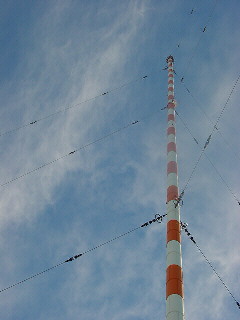Exercise 2.6: Free Space Attenuation
A shortwave transmitter operated according to the modulation method "DSB-AM with carrier" works with carrier frequency $f_{\rm T} = 20 \ \rm MHz$ and transmit power $P_{\rm S} = 100\ \rm kW$. It is designed for a bandwidth of $B_{\rm NF} = 8 \ \rm kHz$ .
For test operation, a mobile receiver is used, which operates with a synchronous demodulator. If this is located at distance $d$ from the transmitter, the attenuation function of the transmission channel can be approximated as follows:
- $$\frac{a_{\rm K}(d, f)}{\rm dB} = 34 + 20 \cdot {\rm lg }\hspace{0.2cm}\frac{d}{\rm km} + 20 \cdot {\rm lg }\hspace{0.2cm}\frac{f}{\rm MHz} \hspace{0.05cm}.$$
This equation describes so-called free space attenuation, which also depends on the (carrier) frequency.
It can be assumed that the entire DSB-AM spectrum is attenuated like the carrier frequency. This means that
- the slightly larger attenuation of the upper sideband (USB), and
- the slightly smaller attenuation of the lower sideband (LSB)
are compensated for by a corresponding pre-distortion at the transmitter.
Let the effective noise power density at the receiver be $N_0 = 10^{–14} \ \rm W/Hz.$
For the first two subtasks, it is assumed that the transmitter transmits only the carrier, which is equivalent to the modulation depth being $m = 0$ .
Hints:
- This exercise belongs to the chapter Synchronous Demodulation.
- Particular reference is made to the page Sink SNR and the performance parameter.
Questions
Solution
- $$\frac{a_{\rm K}(d, f_{\rm T})}{\rm dB} = 34 + 20 \cdot {\rm lg }\hspace{0.1cm}\frac{d}{\rm km} + 20 \cdot {\rm lg }\hspace{0.1cm}\frac{f_{\rm T}}{\rm MHz}= 34 + 20 \cdot {\rm lg }\hspace{0.1cm}(10) + 20 \cdot {\rm lg }\hspace{0.1cm}(20)\approx 80\hspace{0.1cm}{\rm dB} \hspace{0.05cm}.$$
- Dies entspricht einer Leistungsverminderung um den Faktor $10^{8}$:
- $$P_{\rm E}= 10^{-8} \cdot P_{\rm S}= 10^{-8} \cdot 100\,{\rm kW}\hspace{0.15cm}\underline {= 1\, {\rm mW} \hspace{0.05cm}}.$$
(2) Aus $P_{\rm S} = 10^5 \ \rm W$, $P_{\rm E} = 10{^–4}\ \rm W$ folgt eine Freiraumdämpfung von $90 \ \rm dB$. Daraus erhält man weiter:
- $$20 \cdot {\rm lg }\hspace{0.1cm}\frac{d}{\rm km} = ( 90-34 - 26)\hspace{0.1cm}{\rm dB}= 30\,{\rm dB}\hspace{0.3cm} \Rightarrow \hspace{0.3cm} d = 10^{1.5}\,{\rm km}\hspace{0.15cm}\underline { = 31.6\,{\rm km}\hspace{0.05cm}}.$$
(3) Bei ZSB–AM ohne Träger, das heißt für den Modulationsgrad $m → ∞$, würde gelten:
- $$ \rho_{v } = \frac{\alpha_{\rm K}^2 \cdot P_{\rm S}}{{N_0} \cdot B_{\rm NF}} = \frac{ P_{\rm E}}{{N_0} \cdot B_{\rm NF}}= \frac{10^{-4}\,{\rm W}}{10^{-14}\,{\rm W/Hz}\cdot 8 \cdot 10^{3}\,{\rm Hz} } = 1.25 \cdot 10^6\hspace{0.3cm} \Rightarrow \hspace{0.3cm} 10 \cdot {\rm lg }\hspace{0.1cm}\rho_{v } \approx 61\,{\rm dB}\hspace{0.05cm}.$$
- Mit dem Modulationsgrad $m = 0.5$ wird das Sinken–SNR um den Faktor $[1 +{2}/{m^2}]^{-1} = {1}/{9}$ kleiner. Der Sinken–Störabstand ist somit ebenfalls geringer:
- $$ 10 \cdot {\rm lg }\hspace{0.1cm}\rho_{v } = 61\,{\rm dB}- 10 \cdot {\rm lg }\hspace{0.1cm}(9) \hspace{0.15cm}\underline {\approx 51.5\,{\rm dB}\hspace{0.05cm}}.$$
(4) Entsprechend den Berechnungen zur Teilaufgabe (3) muss nun folgende Bedingung erfüllt sein:
- $$ 10 \cdot {\rm lg }\hspace{0.1cm}\left({1 + {2}/{m^2}}\right) < 1\,{\rm dB}\hspace{0.3cm}\Rightarrow \hspace{0.3cm} 1 +{2}/{m^2} < 10^{0.1}=1.259 \hspace{0.3cm} \Rightarrow \hspace{0.3cm}{2}/{m^2} < 0.259 \hspace{0.3cm}\Rightarrow \hspace{0.3cm} m > \sqrt{8}\approx 2.83 \hspace{0.3cm}\Rightarrow \hspace{0.3cm} m_{\rm min} \hspace{0.15cm}\underline {= 2.83} \hspace{0.05cm}.$$
(5) Richtig sind die Vorschläge 1 und 3:
- Bei Verwendung eines Synchrondemodulators macht die Zusetzung des Trägers keinen Sinn, außer, dieser ist für die erforderliche Trägerrückgewinnung nützlich.
- Da der Träger zur Demodulation nicht genutzt werden kann, steht nur ein Bruchteil der Sendeleistung für die Demodulation zur Verfügung $($ein Drittel bei $m = 1$, ein Neuntel bei $m = 0.5)$.
